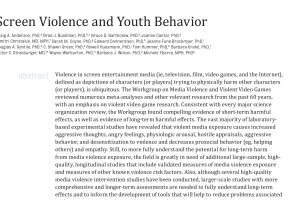Abstract
Violence in screen entertainment media (ie, television, film, video games, and the Internet), defined as depictions of characters (or players) trying to physically harm other characters (or players), is ubiquitous. The Workgroup on Media Violence and Violent Video Games reviewed numerous meta-analyses and other relevant research from the past 60 years, with an emphasis on violent video game research. Consistent with every major science organization review, the Workgroup found compelling evidence of short-term harmful effects, as well as evidence of long-term harmful effects. The vast majority of laboratory based experimental studies have revealed that violent media exposure causes increased aggressive thoughts, angry feelings, physiologic arousal, hostile appraisals, aggressive behavior, and desensitization to violence and decreases prosocial behavior (eg, helping others) and empathy. Still, to more fully understand the potential for long-term harm from media violence exposure, the field is greatly in need of additional large-sample, highquality, longitudinal studies that include validated measures of media violence exposure and measures of other known violence risk factors. Also, although several high-quality media violence intervention studies have been conducted, larger-scale studies with more comprehensive and longer-term assessments are needed to fully understand long-term effects and to inform the development of tools that will help to reduce problems associated with aggression and violence. The evidence that violent screen media constitutes a causal risk factor for increased aggression is compelling. Modern social-cognitive theories of social behavior provide useful frameworks for understanding how and why these effects occur.
This article was published in a special 2017 supplement of Pediatrics, a journal of the American Academy of Pediatrics. The supplement, “Children, Adolescents and Screens: What We Know and What We Need To Learn,” was produced by Children and Screens and includes the contributions of more than 130 interdisciplinary authors across 22 papers. See a complete list of articles included in the supplement.
